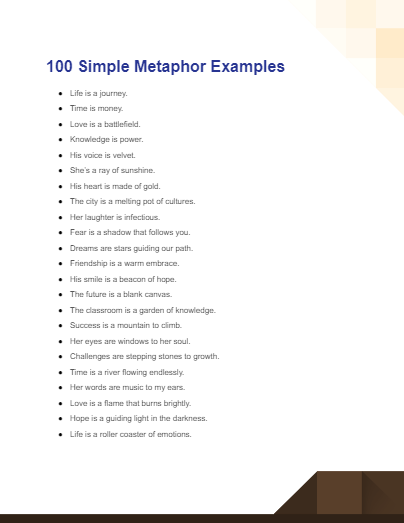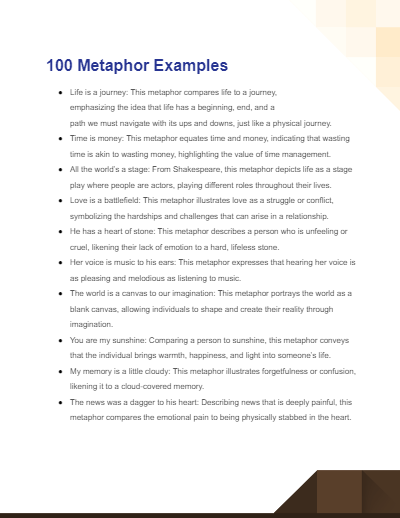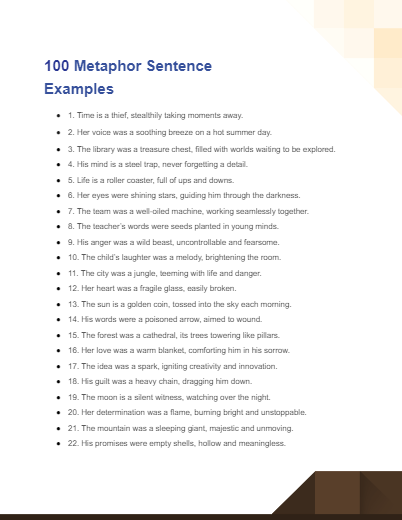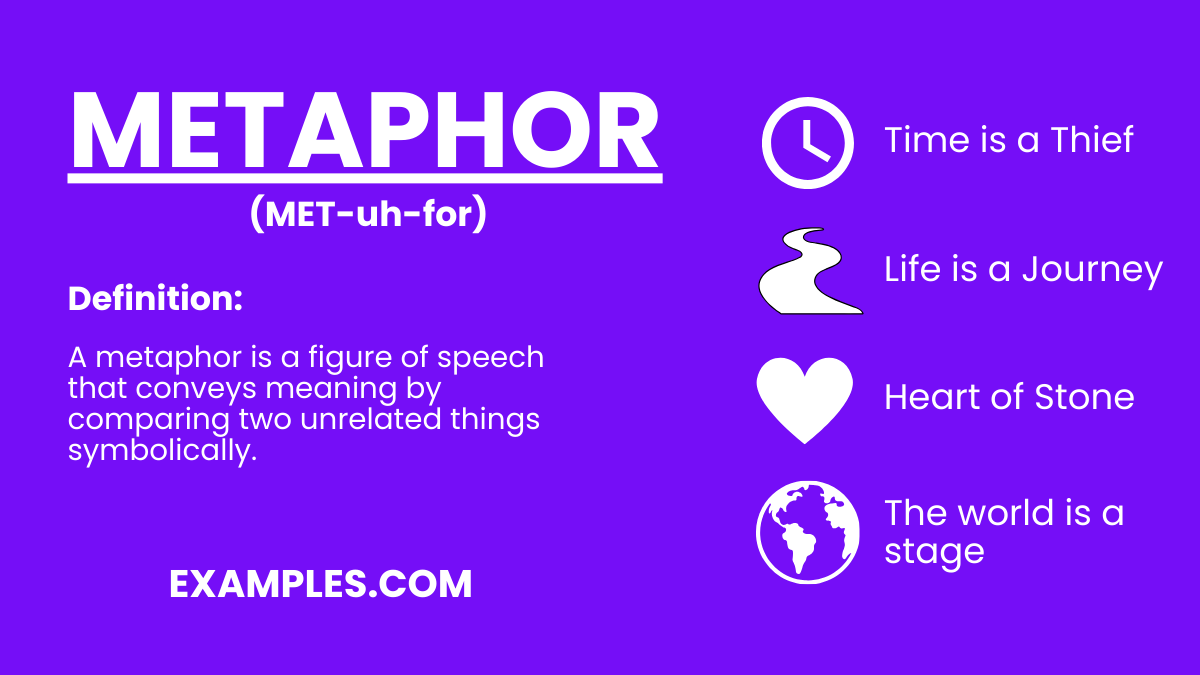Metaphor
Metaphors, the language’s hidden gems, have the power to turn ordinary expressions into captivating imagery. In this guide, we delve into the realm of simple metaphor examples, demonstrating how a single comparison can breathe life into your words. From understanding the basics to crafting your metaphors, we provide insights and tips to help you wield this creative tool effectively. Elevate your communication and let your words paint vivid mental pictures with the magic of metaphors.
What is a Metaphor? – Meaning & Definition
(MET-uh-for)
A metaphor is a way of describing something by saying it is something else that has similar qualities. It’s not meant to be taken literally but helps to create a vivid image or make a point. For example, saying “time is a thief” means time passes quickly and takes moments away, just like a thief takes things. Metaphors make descriptions more interesting or powerful by showing how two different things are alike in a certain way.
What is the Best Example of Metaphor?
“The world is a stage” is one of the best examples of a metaphor. This metaphor compares the world to a stage, where people play various roles and interact, just like actors in a play. It vividly captures the idea that life is like a theatrical performance, with individuals taking on different roles and experiences. This popular metaphor is widely recognized and has been used for centuries to convey the complexities of human existence.
Famous Metaphor Examples
- “Digital footprint in the sands of cyberspace” – Suggesting online actions leave lasting marks in the digital world.
- “The Internet is a global village” – Implying the Internet creates interconnectedness akin to a small community.
- “Social media is the new town square” – Indicating that social media is the modern space for public discourse and gathering.
- “Smartphones are the Swiss Army knives of technology” – Conveying that smartphones offer a versatile range of tools and functions.
- “Streaming services are the new age libraries” – Signifying that streaming platforms are vast sources of digital entertainment and knowledge.
- “Virtual reality is a parallel universe” – Denoting that virtual reality offers an alternate, immersive digital world.
- “Cryptocurrency is the wild west of finance” – Suggesting that the cryptocurrency market is unregulated and adventurous, like the old American West.
- “Artificial intelligence is the brainchild of technology” – Illustrating AI as the innovative and intelligent product of modern technology.
- “Data is the new oil of the digital economy” – Implies that data, like oil, is a valuable, driving resource in the digital age.
- “The gig economy is a mosaic of diverse jobs” – Reflects the variety and flexibility of short-term, freelance job opportunities in the gig economy.
- “Mind like a steel trap” – Implies someone has a sharp, quick-thinking, and retentive memory.
- “Emotions are a rollercoaster” – Suggests that emotions can rapidly change, going through highs and lows.
- “Ideas are seeds of innovation” – Indicates that ideas are the starting point that grows into new, creative solutions or inventions.
- “Life is a tapestry” – Conveys that life is made up of various interwoven experiences and stories.
- “Courage is a shield” – Denotes that courage acts as protection against fear and adversity.
- “Laughter is sunshine for the soul” – Implies that laughter brings warmth and happiness to one’s inner being.
- “Words are the paintbrush of imagination” – Suggests that words can vividly create or portray imaginative scenes and ideas.
- “Dreams are the architects of destiny” – Indicates that dreams shape and design one’s future.
- “Hope is a lighthouse in troubled waters” – Signifies that hope guides and provides refuge during difficult times.
- “The mind is an ocean of thoughts” – Reflects the vast, deep, and sometimes turbulent nature of human thoughts.
- “Time is a silent thief” – Implies time stealthily takes moments away.
- “Fear is a dark shadow” – Suggests fear looms over and follows one.
- “Trust is a fragile glass” – Indicates that trust, once broken, is hard to repair.
- “Anger is a blazing flame” – Conveys that anger is intense and consuming.
- “Memory is a dusty attic” – Reflects on how memories can be old and forgotten.
- “A conversation is a dance of words” – Suggests an exchange of words as rhythmic and coordinated as a dance.
- “Guilt is a heavy chain” – Implies guilt weighs one down like a heavy burden.
- “Curiosity is a bright spark” – Denotes that curiosity ignites interest and learning.
- “Disappointment is a bitter pill” – Indicates that disappointment is hard to accept, like a distasteful medicine.
- “Success is a mountain peak” – Represents success as a high, challenging point to reach.
100 Simple Metaphor Examples

- Life is a journey.
- Time is money.
- Love is a battlefield.
- Knowledge is power.
- His voice is velvet.
- She’s a ray of sunshine.
- His heart is made of gold.
- The city is a melting pot of cultures.
- Her laughter is infectious.
- Fear is a shadow that follows you.
- Dreams are stars guiding our path.
- Friendship is a warm embrace.
- His smile is a beacon of hope.
- The future is a blank canvas.
- The classroom is a garden of knowledge.
- Success is a mountain to climb.
- Her eyes are windows to her soul.
- Challenges are stepping stones to growth.
- Time is a river flowing endlessly.
- Her words are music to my ears.
- Love is a flame that burns brightly.
- Hope is a guiding light in the darkness.
- Life is a roller coaster of emotions.
- His wisdom is a guiding compass.
- Dreams are seeds waiting to sprout.
- The world is a stage and we are actors.
- Friendship is a ship that never sinks.
- Courage is a roaring lion.
- Her tears are raindrops falling from the sky.
- Love is a puzzle with missing pieces.
100 Metaphor Examples

Below is a list of popular metaphor examples from literature, songs, speeches, and everyday expressions. These examples showcase the diverse and creative ways metaphors can be used to convey thoughts and emotions.
- Life is a journey: This metaphor compares life to a journey, emphasizing the idea that life has a beginning, end, and a path we must navigate with its ups and downs, just like a physical journey.
- Time is money: This metaphor equates time and money, indicating that wasting time is akin to wasting money, highlighting the value of time management.
- All the world’s a stage: From Shakespeare, this metaphor depicts life as a stage play where people are actors, playing different roles throughout their lives.
- Love is a battlefield: This metaphor illustrates love as a struggle or conflict, symbolizing the hardships and challenges that can arise in a relationship.
- He has a heart of stone: This metaphor describes a person who is unfeeling or cruel, likening their lack of emotion to a hard, lifeless stone.
- Her voice is music to his ears: This metaphor expresses that hearing her voice is as pleasing and melodious as listening to music.
- The world is a canvas to our imagination: This metaphor portrays the world as a blank canvas, allowing individuals to shape and create their reality through imagination.
- You are my sunshine: Comparing a person to sunshine, this metaphor conveys that the individual brings warmth, happiness, and light into someone’s life.
- My memory is a little cloudy: This metaphor illustrates forgetfulness or confusion, likening it to a cloud-covered memory.
- The news was a dagger to his heart: Describing news that is deeply painful, this metaphor compares the emotional pain to being physically stabbed in the heart.
Types of Metaphor
Metaphors come in various forms, each serving a unique purpose in language and expression. Here are some common types:
1. Standard Metaphors
- Directly compare two unrelated things, saying one thing is another.
- Example: “The world is a stage.”
2. Implied Metaphors
- Suggest the comparison without directly stating it.
- Example: Describing someone as “barked commands” implies they are like a dog.
3. Extended Metaphors
- Stretch a metaphor over a longer portion of text, even an entire work.
- Example: An entire poem describing life as a journey with various stops.
4. Dead Metaphors
- Used so often they’ve become part of regular language, losing their metaphorical punch.
- Example: “Foot of the bed” is so common it’s no longer seen as a metaphor.
5. Mixed Metaphors
- Combine multiple metaphors, often in a way that can be confusing or humorous.
- Example: “We’ll burn that bridge when we get to it” mixes two separate metaphors.
6. Absolute Metaphors
- Make a comparison that seems illogical or bizarre, creating a striking image.
- Example: “Time is a dressmaker specializing in alterations.”
7. Visual Metaphors
- Use visual elements (often in art or film) to convey a metaphorical meaning.
- Example: A wilted flower in a movie to symbolize loss or decay.
Metaphors Vs Similes Vs Analogy Vs Allegory
| Feature | Metaphor | Simile | Analogy | Allegory |
|---|---|---|---|---|
| Definition | A figure of speech that directly compares two different things, stating one thing is another. | Simile is a figure of speech that compares two different things using “like” or “as.” | Analogy is a comparison between two things for the purpose of explanation or clarification. | Allegory is a narrative in which characters and events represent broader themes or ideas. |
| Usage | To create a vivid or imaginative description by asserting a direct likeness. | To illustrate similarities between two different things, making the description more explicit. | To explain or describe one thing by comparing it with a more familiar thing. | To convey deeper meanings, often moral, social, or political, through a symbolic story. |
| Example | “Life is a rollercoaster.” (Life is directly compared to a rollercoaster.) | “Life is like a rollercoaster.” (Life is compared to a rollercoaster using “like.”) | “Just as a caterpillar transforms into a butterfly, a student evolves through education.” | “Animal Farm” by George Orwell, where farm animals represent political figures. |
| Characteristics | Direct comparison without “like” or “as.” | Uses “like” or “as” for comparison. | Involves a more detailed and explanatory comparison. | Extended metaphor, with characters, events, and settings symbolizing deeper ideas. |
| Purpose | To add vividness and creativity to descriptions. | To make descriptions more relatable and understandable. | To make complex or abstract ideas more comprehensible. | To illustrate and critique societal norms, moral lessons, or human behaviors. |
100 Metaphor Sentence Examples

- His heart was a fortress, guarded and impenetrable.
- The skyline was a jagged graph, charting the city’s growth.
- Her imagination was a kaleidoscope, colorful and ever-changing.
- The news was a wake-up call, jarring and urgent.
- His pride was a towering wall, isolating him from others.
- The melody was a gentle river, flowing sweetly.
- Her innocence was a delicate flower, easily bruised.
- The struggle was an uphill battle, demanding and strenuous.
- His touch was electric, sparking excitement.
- The market is a battlefield, competitive and ruthless.
- Her nostalgia was a soft echo, lingering in the background.
- The moon was a silver boat, sailing across the night sky.
- His secret was a locked box, secure and hidden.
- The speech was a home run, winning and decisive.
- Her youth was a fleeting shadow, quickly passing.
- The desert was a barren wasteland, devoid of life.
Metaphors in Daily Life
Daily life is filled with metaphors that help us convey our thoughts, feelings, and experiences more vividly. Here are some daily life metaphor examples:
- Life is full of highs and lows, just like a thrilling roller coaster ride.
- Time’s value is immense, comparable to the worth of money.
- Everyone plays their own part in life, as if on a theatrical stage.
- A day so busy and chaotic it’s like being caught in a whirlwind.
- A challenging struggle, much like climbing a steep hill.
- Destroying relationships in a way that makes it hard to rebuild them.
- Their relationship was a ticking time bomb.
- Memory is a tapestry woven with stories.
- Eyes are the windows to the soul.
- His words cut deeper than a knife.
Easy Metaphor Examples for Kids
Introduce children to the enchanting world of kid friendly metaphors with relatable comparisons like “smile is sunshine” or “friendship is a warm blanket.” These simple metaphors spark their imagination and language skills while making learning enjoyable.
- Her smile is a sunshine that brightens everyone’s day.
- His laughter is like a contagious bubble of joy.
- Learning new things is like discovering hidden treasures.
- Friendship is a warm blanket that comforts you.
- Curiosity is a hungry monster that loves to explore.
- Time is a speedy train that never stops.
- Imagination is a magical wand that brings dreams to life.
- Kindness is a soft pillow that makes the world cozy.
- Happiness is a rainbow that appears after the rain.
- Family is a sturdy shelter that keeps you safe.
Good Metaphor Examples for Students
Empower students with metaphors that make learning engaging. Discover how “studying fuels the brain’s engine” and “creativity is a toolbox of colorful ideas.” These relatable comparisons enrich their understanding and academic journey.
- Studying is like fueling your brain’s engine.
- Concentration is a laser beam of focus.
- Writing an essay is like building a sturdy house of words.
- Learning is a journey through the landscape of knowledge.
- Creativity is a toolbox full of colorful ideas.
- The teacher’s guidance is a guiding light in the academic maze.
- Problem-solving is like untangling a tricky puzzle.
- Goals are stepping stones toward success.
- Knowledge is a treasure trove waiting to be explored.
- Memory is a filing cabinet that stores life’s lessons.
Most Popular Metaphor Examples for Poems
Elevate your poetry with captivating metaphors like “love is a delicate rose” or “time is a river that flows endlessly.” These poetic metaphor comparisons infuse depth and emotion into your verses, creating vivid imagery for your readers.
- Love is a delicate rose, fragile yet beautiful.
- Time is a river that never ceases to flow.
- The heart is a canvas where emotions paint their masterpiece.
- Hope is a candle that flickers against the darkness.
- Dreams are seeds that bloom into aspirations.
- Friendship is a sturdy bridge connecting hearts.
- Wisdom is a lantern guiding us through life’s journey.
- Life is a book with pages filled with stories.
- Happiness is a melody that dances in the air.
- Challenges are storms that test our resilience.
Hidden Personification Metaphor Examples
Breathe life into inanimate objects using personality metaphors. Experience the wind “whispering secrets,” stars “winking mischievously,” and leaves “whispering secrets.” These relatable and imaginative metaphors give objects human-like qualities.
- The wind whispered secrets through the trees.
- The sun smiled warmly upon the earth.
- The flowers danced in the gentle embrace of the breeze.
- The river sang a soothing lullaby as it flowed.
- The stars winked mischievously in the night sky.
- The moon watched over the world with a silent gaze.
- The waves greeted the shore with playful splashes.
- The leaves whispered secrets to each other in the forest.
- The door creaked as if it was telling a tale of its own.
- The clock raced against time with a determined tick-tock.
Metaphor Examples About a Tree
Explore the natural world through metaphors about trees. Delve into comparisons like “branches are arms reaching out” and “roots are the anchor.” These metaphors paint vivid pictures of trees’ beauty, strength, and significance in nature.
- The tree’s branches are arms reaching out to the sky.
- The leaves are a symphony of colors in the autumn breeze.
- The trunk is a sturdy pillar that supports life above.
- Roots are the anchor that keeps the tree grounded.
- The canopy is a protective umbrella shielding from the sun.
- The tree’s growth is a journey toward the sky’s embrace.
- The bark is a protective coat, weathered by time.
- Branches are nature’s sculptures, reaching for the heavens.
- The tree is a storyteller, whispering tales to the wind.
- Leaves are nature’s painters, adorning the tree with beauty.
List of Metaphor Examples About Love
Capture the essence of love with metaphors that evoke emotions. Discover how “love is a warm blanket” and “presence is a comforting shelter.” These love metaphors illuminate the intricate feelings and connections that love brings.
- Love is a warm blanket on a cold night.
- Her laughter is the music that fills my heart.
- His presence is a comforting shelter from life’s storms.
- Love is a flame that ignites our souls.
- Love is a bridge that connects two hearts as one.
- Love is a compass that guides us through life’s journey.
- Her smile is the sunshine that brightens my days.
- Love is a treasure chest overflowing with happiness.
- His touch is a gentle breeze that soothes my soul.
- Love is a garden that flourishes with care and attention.
Most Common Metaphor Examples About Education
Uncover the transformative power of education through metaphors. Explore how “learning is a key” and “knowledge is a treasure map.” These metaphors for schools & educational institutions highlight the value of education in shaping minds and futures.
- Learning is a key that opens the door to success.
- Knowledge is a treasure map guiding us to wisdom.
- The classroom is a stage where students perform their roles.
- Education is a bridge that connects dreams to reality.
- Curiosity is a spark that ignites the flames of learning.
- The teacher is a guiding compass in the sea of knowledge.
- Studying is like planting seeds for a future harvest.
- Education is a foundation upon which dreams are built.
- Books are windows that open our minds to new worlds.
- Learning is a journey, and each lesson is a stepping stone.
How to Identify/ Find Metaphors
- Direct Comparisons: Look for statements where one thing is described as being another, like “time is a river.”
- Figurative Language: Identify phrases that can’t be true literally, suggesting a symbolic meaning.
- Unusual Pairings: Notice when two seemingly unrelated things are connected, such as “heart of stone.”
- Contextual Clues: Use the overall context to determine if a phrase is used metaphorically.
- Deeper Meanings: Seek out deeper or hidden meanings behind a phrase, especially when a literal interpretation doesn’t fit.
- Common Metaphors Knowledge: Be familiar with widely used metaphors to easily recognize them.
- Absence of ‘Like’ or ‘As’: Metaphors don’t use these words, unlike similes, which do.
How to Use Metaphors
- Understand Your Audience: Tailor your metaphor to the audience’s experiences, culture, and understanding level.
- Choose Appropriate Concepts: Select relatable and familiar concepts for your metaphor to ensure clarity and resonance.
- Create a Vivid Image: Use your metaphor to paint a clear, vivid picture in the mind of the audience, enhancing their understanding.
- Convey Deeper Meaning: Use metaphors to add deeper, more nuanced meaning to your message, beyond the literal interpretation.
- Keep it Simple: Ensure your metaphor is straightforward and easy to grasp, avoiding overly complex comparisons.
- Use Sparingly: Metaphors are most effective when used judiciously; too many can overwhelm or confuse the audience.
- Maintain Relevance: Ensure your metaphor is directly relevant to the topic or point you are discussing.
- Avoid Clichés: Steer clear of overused metaphors, as they tend to lose their impact and may seem unoriginal.
- Test for Effectiveness: If possible, test your metaphor with a small group for clarity and effectiveness before using it broadly.
- Be Consistent: If you use a metaphor in a piece of communication, maintain consistency in its application throughout.
- Adjust Tone Appropriately: Match the tone of your metaphor (serious, humorous, formal) to the context of your communication.
How to Spell & Pronounce Metaphor?
Metaphor is spelled as M-E-T-A-P-H-O-R.
The word “metaphor” is pronounced as “MET-uh-for” in English.
What is Visual Metaphor?
A visual metaphor uses imagery to represent another concept or idea, conveying a message through visual means.
What does Metaphors do?
Metaphors create vivid imagery and comparisons, enhancing understanding and adding depth to language and concepts.
List of Other Literary Devices & Figurative Languages
| Alliteration | Antithesis | Assonance | Allegory |
| Allusion | Archetype | Fallacy | Anaphora |
| Analogy | Antecedent | Hyperbole | Antagonist |
| Anecdote | Cliche | Colloquialism | Context |
| Content Validity | Deus ex Machina | Diction | Dissonance |
| Double Entendre | Double Negative | Epigram | Epilogue |
| Epistrophe | Epithet | Euphemism | Exposition |
| Flashback | Foil Character | Gaslighting | Gerund |
| Haiku | Hamartia | Imagery | Jargon |
| Juxtaposition | Limerick | Litotes | Metaphor |
| Motif | Non sequiturs | Onomatopoeia | Oxymoron |
| Pacing | Paradox | Parallelism | Pathos |
| Peripeteia | Persona | Personification | Plot |
| Propaganda | Protagonist | Pun | Repetition |
| Rhetorical Context | Sarcasm | Satire | Setting |
| Simile | Soliloquy | Story Beat | Subplot |
| Subtext | Symbolism | Synecdoche | Theme |
| Tone | Rizz |


